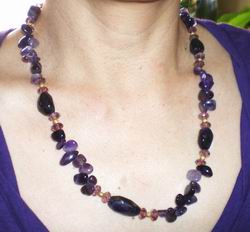
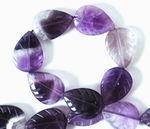
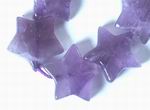

|
|
|
|
|
Amethyst, Lampwork, Bead Boards & Bead Storage
You have received this newsletter because you opted after a past purchase, but should you wish to be taken off the mailing list, just click the link at the bottom. This month’s theme is February's birthstone amethyst + lampwork, bead boards & storage. Scroll down, or click one of the links below on the html version to go to a certain section. If you have any suggestions for the future, please e-mail me at suggestions@mrbead.com.
To go to the MrBead store click here
If you
weren't mailed this newsletter enter your e-mail address
here to receive next month's newsletter.
Amethyst - February's gemstone
How to Store Beads
Special Offer
Amethyst:
The Royal Purple Pope Stone
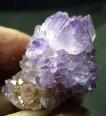
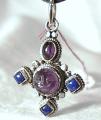
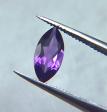
Amethyst is the Birthstone for February, the purple variety of quartz. If it was
not so widespread, amethyst would be very expensive. Its name comes from the
Greek, meaning "not drunken". Perhaps due to a belief that amethyst would sober
the effects of alcohol, or maybe referring to its wine-like color. Although
amethyst is always purple, it comes in shades of pale lilac to deep purple.
Deeper colors are more valuable, “milky” amethyst is the cheapest.
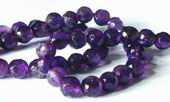
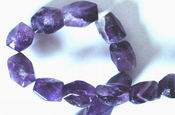
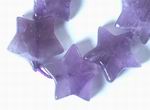
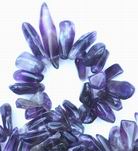
According to Greek mythology, Dionysius, the god of intoxication, was angered by
an insult from a mere mortal and swore revenge on the next mortal that crossed
his path, creating fierce tigers to carry out his wish. Along came unsuspecting
Amethyst, a beautiful young maiden on her way to pay tribute to the goddess
Diana. Diana turned Amethyst into a stature of pure crystalline quartz to
protect her from the brutal claws. Dionysus wept tears of wine in remorse for
his action at the sight of the beautiful statue. The god's tears stained the
quartz purple, creating the gem we know today.
Purple has long been considered a royal color, featured in the British Crown
Jewels and a favorite of Catherine the Great and Egyptian royalty. Leonardo Da
Vinci wrote that amethyst could dissipate evil thoughts and quicken the
intelligence. Because amethyst was believed to encourage celibacy and symbolize
piety, it was very important in the ornamentation of Catholic and other churches
in the Middle Ages. Amethyst is still the stone of bishops who often wear
amethyst rings. Even in Tibet, amethyst is considered to be sacred to the
Buddha.

 Healers and New Agers believe certain gemstones heal on a metaphysical level,
because of the earth's energy that has been absorbed by these stones. Amethyst
is considered to have healing powers of purifying and pacifying - with the
ability to transform lower energies into higher, healing at all levels of mind,
body and spirit. Amethyst’s sobering and calming qualities associate it with
peace. It is known to calm those with constant rigorous mental activity. Called
"nature's tranquilizer", because it also relaxes the whole nervous system.
Amethyst reduces negativity and brings mental strength, stability, and vigor.
Plus understanding to all that is transitional, especially death and rebirth,
providing peace of mind when a loved one is lost. As an elixir, amethyst can
help toothache, bone and joint discomforts and problems with the stomach and
digestive tract. It has also been known to treat various types of blood disease
and balancing blood sugar.
Healers and New Agers believe certain gemstones heal on a metaphysical level,
because of the earth's energy that has been absorbed by these stones. Amethyst
is considered to have healing powers of purifying and pacifying - with the
ability to transform lower energies into higher, healing at all levels of mind,
body and spirit. Amethyst’s sobering and calming qualities associate it with
peace. It is known to calm those with constant rigorous mental activity. Called
"nature's tranquilizer", because it also relaxes the whole nervous system.
Amethyst reduces negativity and brings mental strength, stability, and vigor.
Plus understanding to all that is transitional, especially death and rebirth,
providing peace of mind when a loved one is lost. As an elixir, amethyst can
help toothache, bone and joint discomforts and problems with the stomach and
digestive tract. It has also been known to treat various types of blood disease
and balancing blood sugar.
In yoga, amethyst aids the 6th Chakra, the Third Eye, center of the body’s
spiritual power. Because amethyst heightens awareness, both spiritual and
psychic - increasing intuition and psychic development and transition from a
normal state of consciousness to a deeper awareness.
Amethyst is mined in South American and African countries. African is the best,
but mined in smaller sizes. Very dark amethyst, mostly in small sizes, is also
mined in Australia.
to top
History of Lampwork Beading

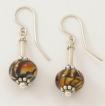
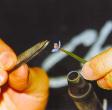
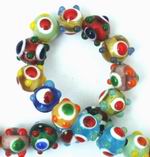
The "lamp" in lampwork came from the oil lamps and blowpipes used in seventeenth
century France and Italy. Blowing by mouth or bellows into an oil lamp flame
with a small pipe makes just enough heat to soften and form this type of glass.
It's amazing the great work the early lampworkers were able to do with so little
equipment. Hot glassworking skills originated from the Syrians around 1700 BC,
the Egyptians 1450 BC, the Chinese around 550 BC, the Romans at the turn of the
first millennium. Today lampworkers usually use an oxygen torch, but the
technique to form and decorate the glass hasn’t changed much for thousands of
years.
Choosing Lampwork Beads
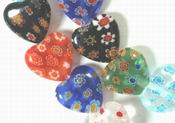
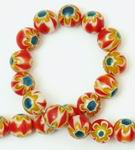

As usual with handcrafted items, the quality is equal to the expertise of its
maker. Choose beaded jewelry in a style you like, but remember that style isn't
the only thing you must consider when buying handcrafted glass beads. Air
bubbles should not normally be visible in the bead – although some beadmakers
use these as design elements, but they are normally round or positioned in
specific areas. The bead hole should be free of nicks or burrs. Jagged edges
around the hole produce a wobbly bead that can eventually cut through beading
wire. Check that the shapes of beads. They're handcrafted, so expect some
variations, that’s part of their charm, but the overall look should be
attractive.
How are Lampwork Beads actually Make?
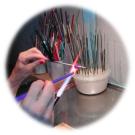
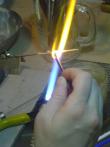
Lampworkers use a torch to melt the tips of glass rods, and then wind the molten
glass around a mandrel, a narrow stainless steel rod. Later, when the bead is
removed, the space occupied by the mandrel becomes the hole used to string the
bead. Glass cools from the outside in and the outer layers shrink as they cool.
Bringing a bead out of the flame and leaving it in the open air allows the
outside of the bead to cool rapidly around its molten interior. However, a
stress point develops between the cool shrinking glass and the hot center, which
can cause a bead to crack immediately or at a later time. To prevent cracks, the
beads are soaked in a kiln to make sure that all glass within them is the same
temperature. After soaking the artist reduces the kiln’s heat over several hours
to bring the beads to room temperature.
to top of page
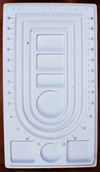 A bead board
can be a beaders’ best friend. Allowing you to try different designs before you
need to actually string the beads - so saving a lot of time and inconvenience of
unstringing a bad design.
A bead board
can be a beaders’ best friend. Allowing you to try different designs before you
need to actually string the beads - so saving a lot of time and inconvenience of
unstringing a bad design.
There are a few different types of bead boards, but all have at least one long groove around the board where you prepare your beads. At the side of this groove are numbers represents an inch and markings for half-an-inch. This helps you measure the final length of your necklace. In the center of most boards are small compartments to store beads as you work.
To make a necklace you need to determine where you want to place your beads in the design. If you already have a pattern to
follow, great, just go ahead and put them in the correct order on the board. However, if you are not sure what pattern you plan to string yet, rearrange the beads until you find a design that you like.
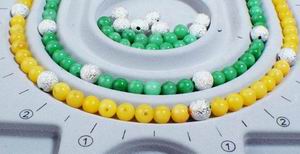
Then string all the beads and spacers together, leaving extra cord for the clasp. Next lay the stung design on the board so you can check its desired length. After this, remove the piece from the bead board and finish it off attaching a crimp bead or a bead tip
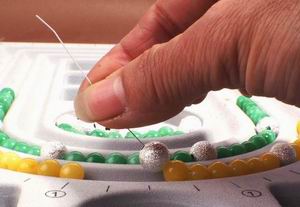
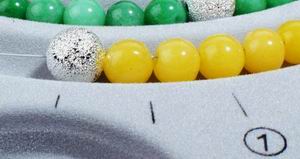
Our gray-flocked plastic bead board pictured, has three channels for laying out beads for single or multiple strand jewelry, and seven compartments to store the beads while you’re working. Overall size: 16 x 9 inches. Just US$12 - to buy click here
.
Eventually every beader is faced with the
dilemma of how to store their beads. Everyone has their own way depending on
quantity and availability. Some beaders use a fishing tackle box, plastic shoe
boxes, wood or plastic utensil trays from Walmart – others, clear sliding
drawers designed for nuts and bolts, plastic pencil cases, or plastic drawer
storage bins. All these compartments are the ideal size for storing beads,
findings, and tools. Sturdy and portable, they allow you see project options at
a glance.
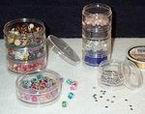


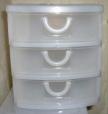
Inside these draws you need to separate different types and sizes of beads. For
loose beads, tubes are good with a label or photo around. Zippy or sealable
plastic bags are great for strands - plus they have the advantage of a large
opening to get a scoop or counter inside to retrieve loose beads. These bags can
be brought from freezer and stationary stores. If you store your beads in
little draws you may still need to put them in plastic bags too - in case the
whole cabinet gets accidentally kicked over!
However, as your collection grows you will need a more and more containers. We
use plastic draws that are stacked together and labeled on the front with a photograph and
a description of the beads inside. Transparent or partly-transparent draws are good for seeing
what’s inside. Another way is to build narrow shelves for baby food jars. You
can even screw the top of the lid to the top of the shelf so they always go back
neatly. For small loose beads you can use 35mm film containers, candy tins,
aspirin bottles, and paint cans for larger beads.
One beader has eight spice racks that turn, brought at yard sales for $2 each.
Plus 16 glass jars with lids for her seed beads. Each jar has several shades of
the same color. She just turns the rack to find the color she’s looking for and
the type of bead. Another beader uses Tic Tac containers when she travels. They
are small enough for all the different colors she needs and they never spill.
She also stores beads in margarine containers because they are flat and she can
pile them on top of one another. Other people use empty travel-size baby-wipe
containers to transport their beads. These are lightweight, the right
depth to hold tubes of beads, and they fit easily into a purse. With a little
imagination, you will find many every-day containers ideal for beads.
to top
To go to all or amethyst beads click here
To go to our lampwork beads click here
For our Bead Board click here
Special 15% Offer !
Sample our beads with 15% off any order from our MrBead bead store, just key in "board" at the checkout (without the
inverted commas) and click "Redeem Coupon".
Offer valid until 6th February only - so act now! Only for use in our store at the checkout and not valid with any other offers.
To go to our MrBead store click
http://www.mrbead.com
To Top of Page
To return to the top of this page click here